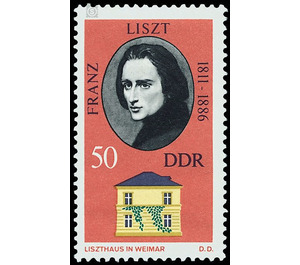Historical memorials in Weimar - Germany / German Democratic Republic 1973 - 50 Pfennig
Theme: Architecture
| Country | Germany / German Democratic Republic |
| Issue Date | 1973 |
| Face Value | 50.00 |
| Color | orange |
| Perforation | K 12 1/2: 13 |
| Printing Type | offset |
| Stamp Type | Postage stamp |
| Item Type | Stamp |
| Chronological Issue Number | 1603 |
| Chronological Chapter | GER-DDR |
| SID | 187596 |
| In 16 Wishlists | |
Historical Memorials in Weimar The Ministry of Posts and Telecommunications of the German Democratic Republic publishes six multi-colored special postal stamps on historical memorials in Weimar. Historical memorial in Weimar 50 Pfennig value: Liszthaus At the entrance to the Goethe Park in the Marienstraße is a one-story, built in 1798 as a residence for the court gardener building. By Franz Liszt (1811 - 1886), who lived in the last years of his life (1869 - 1886), the first floor of the simple building, it has become world famous. Students from all over the world gathered here around the Master whose living quarters have been preserved in their original state. On the ground floor, a museum set up by the National Research and Memorial Sites of Classical German Literature in Weimar informs about the life and work of the great Hungarian piano virtuoso and composer.


